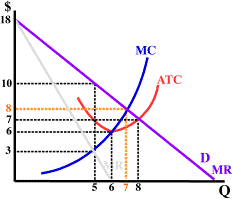 Perfect (1st) price discrimination is essentially impossible, though some
types of sales behavior attempt to achieve this. Since under 1st degree price discrimination each unit is sold at a different
price, and at the highest price the consumer is willing to pay,
the firm will keep selling until the price (which is also MR) of the last unit equals its MC. For this firm the last unit sold will be the 7th unit at a price of 8, since that is the last unit for which P is not below MC.
Perfect (1st) price discrimination is essentially impossible, though some
types of sales behavior attempt to achieve this. Since under 1st degree price discrimination each unit is sold at a different
price, and at the highest price the consumer is willing to pay,
the firm will keep selling until the price (which is also MR) of the last unit equals its MC. For this firm the last unit sold will be the 7th unit at a price of 8, since that is the last unit for which P is not below MC.
4. Suppose the monopolist depicted in Figure 1 is able to practice 1st degree (perfect) price discrimination if it could do this successfully
the total number of units sold and the price of the last unit
sold will be:
- price of last unit = 6, total quantity sold = 6. The 6th unit would sell for much more than a price of 6, so it would
be foolish of the firm to sell it at that price.
- price of last unit = 3, total quantity sold = 5. The 5th unit will sell for a price of 10.
- price of last unit = 10, total quantity sold = 5. This is only profit maximizing if the firm can't price discriminate.
- price of last unit = 7, total quantity sold = 8. Even though the average cost of is equal to price at 8 units,
the MC of the 8th unit is above the price (which is also MR).
- price of last unit = 8, total quantity sold = 7.
Next Question
Copyright © 1995-2004 OnLineTexts.com, Inc. - All Rights Reserved

